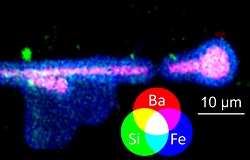What makes asbestos carcinogenic at the atomic level
On inhalation, asbestos triggers a chain of events that can lead to mesothelioma, an aggressive cancer of the lung lining, as well as other lung diseases. After prolonged stay in the lungs, the asbestos fibres develop an iron coating and become known as asbestos bodies, thought to contribute to the toxic cell response, but what exactly triggers this is still unclear. An EU-funded Marie Skłodowska-Curie Fellowship, the BiominAB-3D(opens in new window) project, used state-of-the-art microscopy and synchrotron radiation techniques to unravel the nature of the asbestos bodies. “To achieve this goal, in-depth structural, morphological, chemical, and spectroscopic analyses were carried out combining advanced X-ray microprobe techniques based on synchrotron radiation, with electron microscopies,” explains Dr Fabrizio Bardelli, project researcher. A step by step approach to analyse the asbestos bodies Each investigation technique delved into an aspect of the composition of the asbestos bodies, as they are the interface between the tissue and the foreign fibres. X-ray tomography gave details of the 3D external and internal morphology, and X-ray fluorescence revealed the elements present. For the chemical form of the iron (Fe), thought to be significant in cancer progression, the researchers used X-ray absorption spectroscopy. The structure of the asbestos fibres was revealed by transmission electron microscopy (TEM). Results reveal mesothelioma potential “The synchrotron radiation experiments were fully successful,” reports Dr Bardelli. Results revealed the chemical form and amount of the Fe contained in the asbestos bodies. “The presence and distribution of minor elements, from Silicon to Barium, was also revealed,” he clarifies. Computed tomography revealed the location and spatial density of the asbestos bodies in the lung tissue, and their morphology with an unprecedented level of detail. Combining the information from different techniques it has been possible to calculate the mass density of the asbestos bodies, information that may lead to their chemical composition. Challenges, solutions and the continued fight against mesothelioma A specific sample preparation had to be developed for each investigation technique. Nanotomography experiments required cutting tissue fragments of very small size (1/10 mm), containing at least one asbestos body. “This was only possible using a laser microdissector, which required collaboration with pathologists who use laser microdissection to separate tumour and healthy tissue,” explains Dr Bardelli. “This also led to fruitful collaborations relating to other health issues,” he points out. The observed distribution of silicon suggested that even crocidolite fibres, the most bioresistent asbestos, start to dissolve after prolonged stay in the lungs. This is of interest, because fibre constituents may migrate into the surrounding tissue and have a role in asbestos diseases. Confirmation using TEM is required, as is a compositional and growth model for the asbestos bodies. “This work will be carried out in the next months and further publications are envisaged,” says Dr Bardelli. Asbestos is still a major health threat worldwide. Although banned in all European countries, use of asbestos is still permitted in Canada, Russia, Brazil, China, India and some other Asiatic countries. Dr Bardelli concludes: “The long latency time from exposure to the development of diseases, up to 50 years, means that the peak of mortality is expected within the next few years in most countries, so it is important to keep the level of asbestos danger awareness high, and to carry on researches that can lead to more effective health therapies and prevention strategies.”







